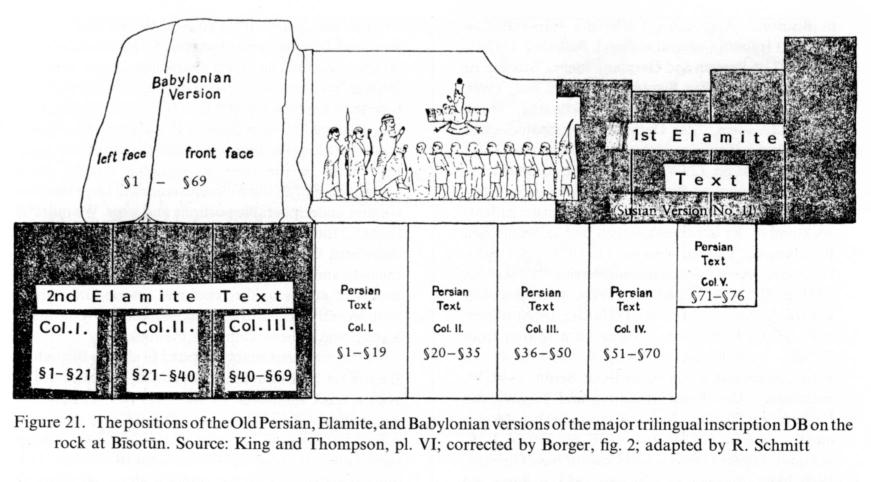I have been meaning to post something about the Bisitun (or Behistun) inscription for ages now, but never seem to get round to it. Noticing that today is International Mountain Day has finally spurred me to action – though this will have to be a short post for now because I don’t have time at the moment to do this wonderful monument the justice it deserves.

The inscription can be found 100m up a cliff, on Mt Behistun in present-day Iran. It’s huge (15 x 25 m) and incorporates images as well as trilingual text in Old Persian, Elamite and Babylonian. All three languages are written in different types of cuneiform, i.e. wedge-shaped writing that was adapted and developed by different societies of the Near East. By the time of this inscription (late 6th or early 5th C BC), cuneiform had already been in use for thousands of years, so what we are seeing here are very late manifestations of a multi-stranded tradition of writing with a very long history.

Images from HERE.
 It was the Persian Great King Darius the Great who commissioned this inscription, starting with a brief autobiography and then commemorating his early successes in putting down a number of rebellions in the Persian Empire. He piously attributes his success to the aid of the god Ahura Mazda, and repeats similar versions of the same text in each of the three languages. The text is positioned in separate sections around a central relief showing Darius with a succession of conquered figures before him, with ropes around their hands and necks; the one at the beginning of the line is lying on the floor beneath Darius’ foot. The god Ahura Mazda is the winged figure above this procession.
It was the Persian Great King Darius the Great who commissioned this inscription, starting with a brief autobiography and then commemorating his early successes in putting down a number of rebellions in the Persian Empire. He piously attributes his success to the aid of the god Ahura Mazda, and repeats similar versions of the same text in each of the three languages. The text is positioned in separate sections around a central relief showing Darius with a succession of conquered figures before him, with ropes around their hands and necks; the one at the beginning of the line is lying on the floor beneath Darius’ foot. The god Ahura Mazda is the winged figure above this procession.
(Seeing as Christmas is coming up, I’d feel remiss if I didn’t point out the figure in the pointed hat at the very right of the procession of conquered peoples… Make of that what you will!)

Back to more serious concerns, one of the reasons I’ve been wanting to mention this inscription is that I’ve been thinking about decipherment a lot lately, for different reasons (see some recent CREWS posts HERE, HERE and HERE). This text and others with a similar trilingual structure played a pivotal role in deciphering and confirming the sign values of all three writing systems: Babylonian (closely related to Akkadian), Elamite and Old Persian cuneiform. The decipherment process for all three involved recognising names, linguistic study and comparison of each of the versions of the text, and the main part of this work was achieved in the early 19th century (this Wikipedia article is a good account of the basic details).

Old Persian cuneiform is likely to make a reappearance on this blog at some point in the future, because it shows some particularly interesting developments in writing – which is what we’re all about at CREWS! For one thing, it must have been created by a deliberate and radical reform of previously attested cuneiform systems. Its main purpose – judging by surviving inscriptions – seems to have been for monumental inscriptions dictated by the central authority of the Persian Empire. This seems to represent the usage of the script well enough, but we should be careful because there is some limited evidence of a slightly wider range of uses, something which appeared in our inscription advent calendar on Saturday:

Returning to the reform of the writing system, there are many different avenues to follow here. The choice of a cuneiform base is interesting in itself, but even more fascinating is the fact that it didn’t just borrow and adapt an earlier form of cuneiform, it created a whole new script with new principles. Rather than the hundreds of syllabograms and logograms used in Babylonian/Akkadian cuneiform, Old Persian cuneiform has just 36 principal main signs with a small set of logograms to accompany them. In type, the script is a sort of semi-syllabary – an issue we will undoubtedly return to in the future (but for now, have a look at this Wikipedia article if you are interested in more details).

The context of use is also intriguing. Most known inscriptions in Old Persian cuneiform are on stone (the one above is a different inscription, from Persepolis), but the small angled wedges of cuneiform scripts are not so easy to carve on such a hard surface, having been developed originally for pressing into clay documents with a stylus. This different usage affects the appearance of signs, and, fortunately for us, makes Old Persian quite easy to read because the signs are carved so clearly in short strokes. The existence of the clay tablet mentioned above, however, shows that it could be written on clay too – so again we have to be careful about the assumptions we make.

One final question to pose is readership. This is an inscription that’s meant to impress, with three carefully cut versions of the text and an accompanying image showing Darius as the pious and successful conqueror in charge of the Persian Empire. But who can you impress in an inscription 100m above ground on a cliff face? The only access to the text is to climb gingerly along a narrow ledge and get close enough to see the signs (I pity the engravers sent to carve it!). I think it must be significant that the images carved between the areas of text are so big – these are easier to see from a distance and potentially to interpret. Perhaps that says something about literacy (let’s assume the average citizen of the Persian Empire is unlikely to have been able to read these cuneiform scripts) – though the god Ahura Mazda may not have had the same problem!
We will have to stop there, even though I’d like to talk about this marvellous inscription and the myriad of questions it poses for hours. It will be making a special appearance in our inscription advent calendar tomorrow too – and if you have missed other inscriptions in the advent calendar, you can find them all by clicking HERE. Thank you for reading!
~ Pippa Steele (Principal Investigator of the CREWS project)



This is so intriguing Thank you for sharing your knowledge.
LikeLike